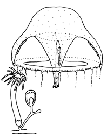
| About | | Search taxa | | Taxon tree | | Search literature | | Checklist | | Stats | | Log in |
ChaRMS taxon detailsEirenidae Haeckel, 1879
15378 (urn:lsid:marinespecies.org:taxname:15378)
accepted
Family
marine,
Haeckel, E. (1879). Das System der Medusen. Erster Teil einer Monographie der Medusen. <em>Denkschriften der Medicinisch-Naturwissenschaftlichen Gesellschaft zu Jena.</em> 1: XX+1-360, 320 plates., available online at https://www.biodiversitylibrary.org/page/32605578
page(s): 199; note: introdcued as Irenidae, which is an icorrectly formed name [details]
Schuchert, P.; Choong, H.; Galea, H.; Hoeksema, B.; Lindsay, D.; Manko, M.; Pica, D. (2025). World Hydrozoa Database. Eirenidae Haeckel, 1879. Accessed through: Xu, K., An, J., Ding, L., Dong, D., Gao, Y., Huang, Y., Jiang, W., Lei, Y., Li, K., Li, X., Li, Y., Liang, X., Lin, G., Lin, M., Liu, H., Liu, J., Liu, W., Liu, X., Lu, D., Ma, Z., Ren, X., Sha, Z., Sun, J., Sun, S., Sun, Z., Tian, L., Wang, D., Wang, J., Wu, X., Xia, B., Xiao, N., Yin, J., Zhang, J., Zhang, S., Zhang, X., Zhao, E., Zheng, X., Zhou, H., Zhou, J. & Zhou, K. (2025) Chinese Register of Marine Species at: https://marinespecies.org/charms/aphia.php?p=taxdetails&id=15378 on 2025-05-08
Xu, K., An, J., Ding, L., Dong, D., Gao, Y., Huang, Y., Jiang, W., Lei, Y., Li, K., Li, X., Li, Y., Liang, X., Lin, G., Lin, M., Liu, H., Liu, J., Liu, W., Liu, X., Lu, D., Ma, Z., Ren, X., Sha, Z., Sun, J., Sun, S., Sun, Z., Tian, L., Wang, D., Wang, J., Wu, X., Xia, B., Xiao, N., Yin, J., Zhang, J., Zhang, S., Zhang, X., Zhao, E., Zheng, X., Zhou, H., Zhou, J. & Zhou, K. (2025). Chinese Register of Marine Species. Eirenidae Haeckel, 1879. Accessed at: https://marinespecies.org/charms/aphia.php?p=taxdetails&id=15378 on 2025-05-08
Date action by 2004-12-21 15:54:05Z created db_admin
original description
Haeckel, E. (1879). Das System der Medusen. Erster Teil einer Monographie der Medusen. <em>Denkschriften der Medicinisch-Naturwissenschaftlichen Gesellschaft zu Jena.</em> 1: XX+1-360, 320 plates., available online at https://www.biodiversitylibrary.org/page/32605578
page(s): 199; note: introdcued as Irenidae, which is an icorrectly formed name [details] context source (Hexacorallia) Fautin, Daphne G. (2013). Hexacorallians of the World. (look up in IMIS) [details] basis of record Bouillon, J.; Boero, F. (2000). Synopsis of the families and genera of the Hydromedusae of the world, with a list of the worldwide species. <i>Thalassia Salent. 24</i>: 47-296 (look up in IMIS) [details] |


